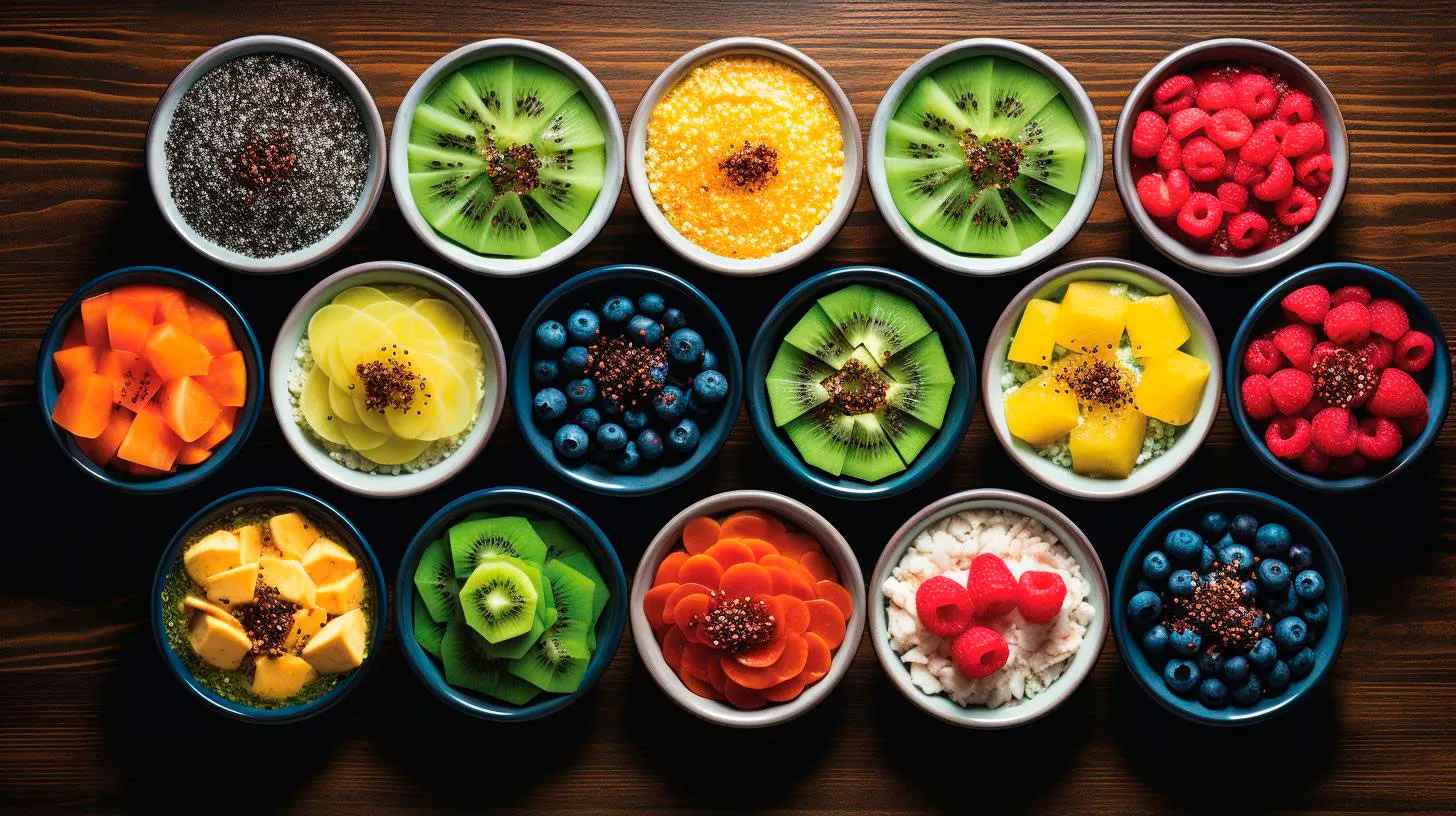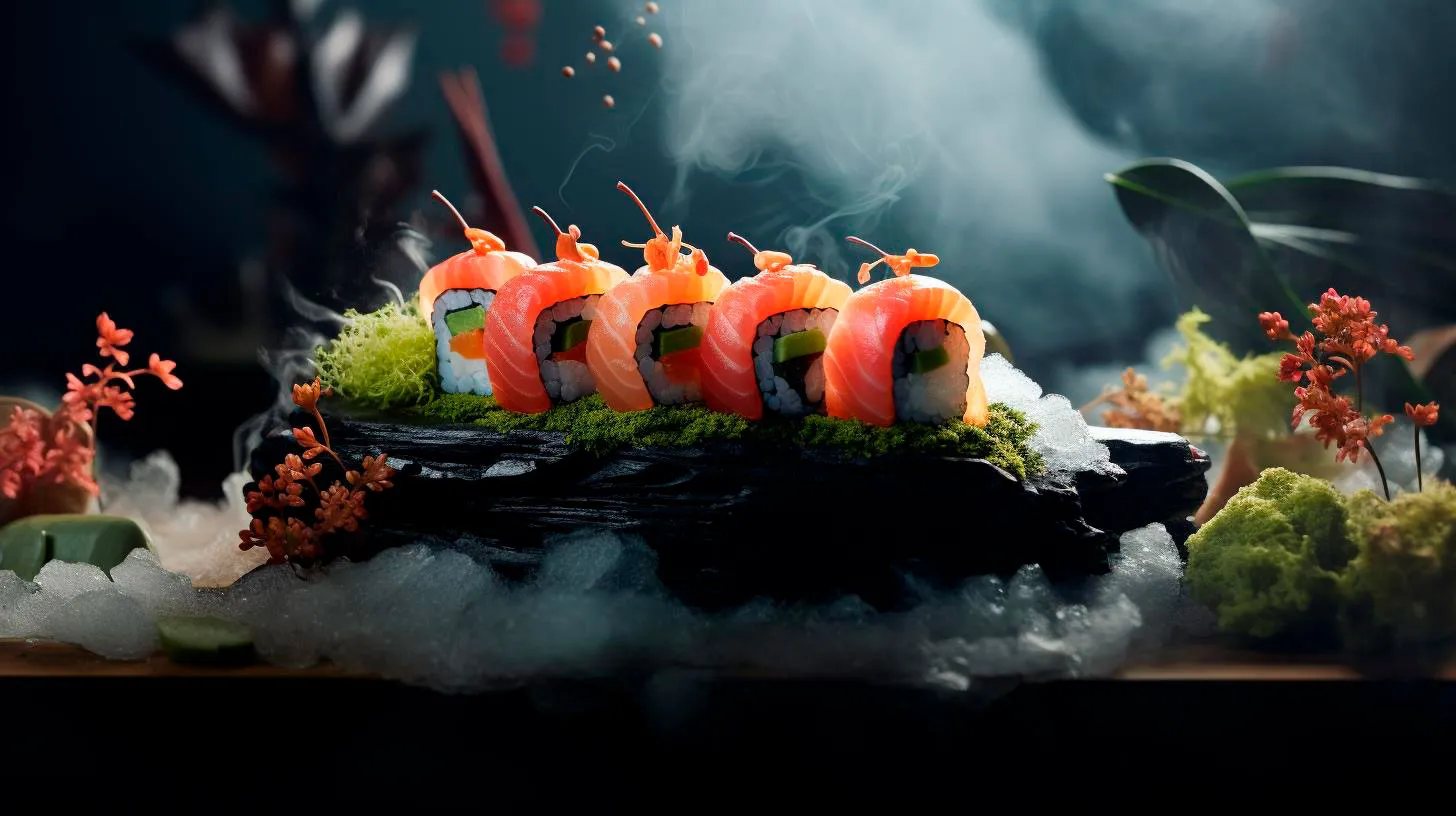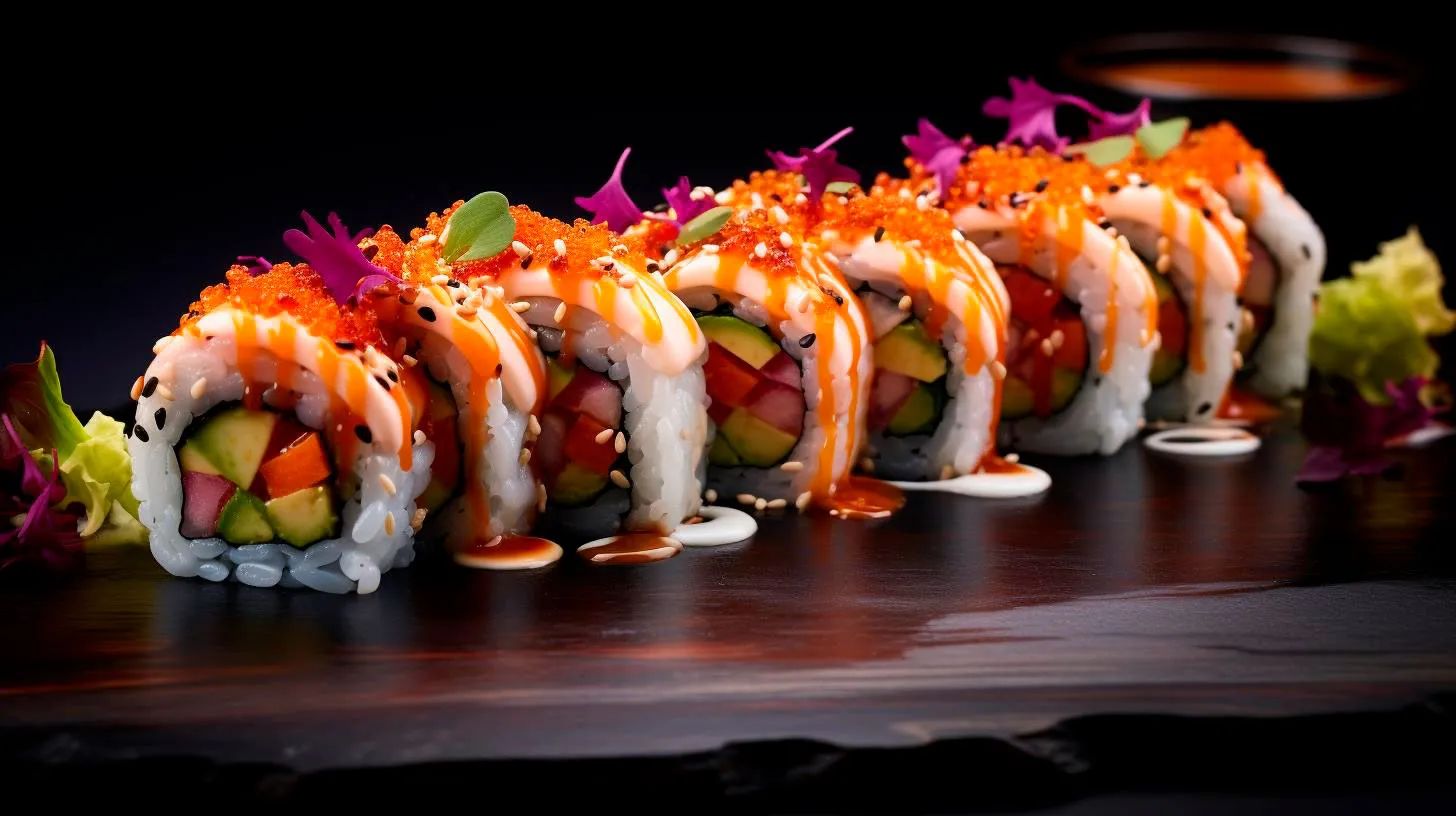Unlocking the Secrets Vinegared Rice and Its Significance in Sushi Making
In this article, we will delve into the secrets of vinegared rice, its significance in sushi making, and why it is the key to creating that perfect sushi experience.
The Basics of Vinegared Rice
Vinegared rice, known as “shari” in Japanese, is the cornerstone of sushi. It is made by combining cooked short-grain Japanese rice with a delicate balance of vinegar, sugar, and salt. This simple yet transformative process infuses each grain of rice with a delicious umami flavor while providing the perfect texture and stickiness required for sushi.
Key Takeaway: The precise combination of vinegar, sugar, and salt is vital in achieving the perfect flavor and texture of vinegared rice.
The Significance of Vinegared Rice in Sushi Making
1. Balance and Harmony: Vinegared rice forms the foundation of sushi, balancing the flavors from various ingredients such as fish, vegetables, and sauces. It acts as a neutralizer, enhancing the taste of fillings without overpowering them.
2. Texture and Structure: The stickiness of vinegared rice plays a crucial role in the shaping and assembly of sushi. It allows the delicate layers of ingredients to stay together, whether it’s a classic nigiri or a rolled maki.
3. Preservation and Safety: The vinegar in the rice acts as a natural preservative, inhibiting the growth of bacteria and ensuring the safety of the sushi. This is especially important when using raw fish or seafood as sushi fillings.
Key Takeaway: Vinegared rice brings balance to the flavors, provides structure to sushi, and ensures its safety through natural preservation.
Mastering the Art of Vinegared Rice
Creating the perfect vinegared rice requires skill, precision, and attention to detail. Here are some expert tips to help you master this fundamental element of sushi making:
- Choosing the Right Rice: Opt for short-grain Japanese rice, such as “sushi rice” or “Calrose rice,” known for its sticky texture when cooked.
- Rinsing the Rice: Thoroughly rinse the rice to remove excess starch, ensuring a clean and polished finish.
- Proper Measurements: Use the ideal ratio of rice to vinegar, sugar, and salt to achieve the desired balance of flavors. A common ratio is 1:1.25:0.25 (rice:vinegar:sugar/salt).
- Stir and Cool: Gently mix the vinegar mixture into the cooked rice while fanning it to cool down and prevent overcooking. This helps maintain the individual texture of each grain.
- Quality Ingredients: Choose high-quality rice vinegar, preferably the “seasoned” variety specifically made for sushi rice, for the best results.
Key Takeaway: Mastering vinegared rice requires choosing the right rice, precise measurements, and proper mixing techniques.
The Science of Umami
One of the reasons vinegared rice is so irresistible is the umami flavor it carries. Umami, often described as the “fifth taste,” adds depth and savoriness to dishes. When vinegar is combined with rice, it enhances the umami taste, making the sushi experience more flavorful and enjoyable.
Studies have shown that umami taste elevates the overall dining experience by stimulating taste buds and satisfying cravings. It creates a harmonious balance of flavors and intensifies the enjoyment of each bite of sushi.
Key Takeaway: The combination of vinegar and rice enhances the umami taste, creating a more flavorful sushi experience.
The Perfect Pairings
To complete the sushi experience, vinegared rice is traditionally paired with various fillings, resulting in an endless array of sushi types:
- Nigiri Sushi: A classic type of sushi where vinegared rice is topped with slices of raw or cooked seafood, such as tuna, salmon, or shrimp.
- Maki Sushi: Sushi rolls made by wrapping vinegared rice and fillings in sheets of seaweed (nori) and cutting them into bite-sized pieces.
- Temaki Sushi: Hand-rolled sushi cones, where vinegared rice and fillings are wrapped in a cone-shaped seaweed wrap.
- Chirashi Sushi: A colorful dish with vinegared rice topped with an assortment of sashimi, vegetables, and other toppings.
These are just a few examples of the endless possibilities that vinegared rice brings to sushi making, allowing for creativity and customization to suit different tastes and preferences.
Key Takeaway: Vinegared rice is the versatile base that pairs perfectly with a variety of fillings, resulting in an array of sushi types.
In conclusion, vinegared rice is the secret ingredient that unlocks the flavors, textures, and overall sushi experience. Its significance lies in balancing flavors, providing structure, ensuring safety, and enhancing the umami taste. By mastering the art of vinegared rice and exploring its endless pairings, you can embark on a delicious journey through the world of sushi-making, creating your own unique and flavorful creations.
From Grain to Flavor: Exploring the Crucial Role of Vinegared Rice in Sushi
Today, we embark on a journey to explore the importance of vinegared rice in sushi and how it elevates this delectable dish to new heights.
The Art of Sushi Rice Preparation
Preparing sushi rice is no ordinary task – it requires precision, patience, and a deep understanding of the flavors that each grain brings to the table. The process begins with selecting the right type of rice, traditionally a short-grain variety. The grains are then carefully washed to remove excess starch, ensuring that the rice remains sticky but not overly glutinous. Once rinsed, the rice is cooked in the ideal ratio of water to achieve the perfect texture.
After cooking, the rice is transferred to a wooden or bamboo container known as a hangiri. The key step in making sushi rice is the addition of sushi vinegar. This unique blend of rice vinegar, salt, and sugar adds a delightful tanginess and sweetness to the rice. The vinegar is gently mixed into the rice using a shamoji, a Japanese rice spatula, while simultaneously fanning the rice to cool it down and enhance its stickiness.
Through this meticulous process, sushi chefs create vinegared rice that is fluffy, moist, and perfectly seasoned. The acidity from the vinegar not only enhances the taste but also acts as a natural preservative, allowing sushi to maintain its freshness for longer periods.
Enhancing the Sushi Experience
Vinegared rice is the foundation of sushi, working in harmony with other components to create a symphony of flavors. Here are some reasons why sushi rice is indispensable:
- Texture: Sushi rice has a unique stickiness that helps hold the shape of sushi rolls and nigiri. Its pliable texture adds a pleasant mouthfeel, promoting a satisfying dining experience.
- Balance: The vinegared rice’s acidity creates a delicate balance with the richness of other ingredients like fresh fish or creamy avocado, resulting in a harmonious flavor profile that is neither overpowering nor bland.
- Preservation: The combination of vinegar, salt, and sugar acts as a natural preservative, preventing harmful bacteria from proliferating and ensuring the optimal freshness of the sushi.
- Umami Amplifier: The umami taste, often described as the fifth taste, is enhanced by the vinegar in the sushi rice. It enriches the overall flavor of the dish, tantalizing taste buds with its savory and irresistible notes.
When paired with other ingredients like fresh fish, vegetables, or pickled ginger, sushi rice brings together a delightful medley of flavors that pleases both the palate and the senses.
The Perfect Companion for Your Sushi Cravings
As sushi continues to gain popularity worldwide, it is essential to ensure that the sushi rice you use matches the high standards set by professional sushi chefs. Opting for high-quality rice and sushi vinegar will greatly enhance your homemade sushi experience.
For sushi enthusiasts looking to recreate the magic at home, it is recommended to use short-grain Japanese rice, also known as Japonica rice. This variety has the perfect balance of moisture, stickiness, and texture required for authentic sushi rice.
When selecting sushi vinegar, explore different types available in the market, each offering a unique flavor profile. Experiment with the ratios of rice vinegar, salt, and sugar to find your preferred balance and create a customized sushi rice that suits your taste buds.
In Summary
Vinegared rice, or sushi rice, acts as the backbone of sushi, adding not only flavors but also key functional properties. Its delicate balance of acidity, texture, and preservation preserves the freshness of the ingredients and harmonizes the overall flavors. Understanding the importance of sushi rice enables us to appreciate the true essence of sushi and elevate our culinary experiences.
So, next time you dig into a delicious sushi roll or savor a piece of nigiri, remember the magical journey of transforming grains of rice into a humble yet essential element that brings joy to your taste buds.
The Art of Crafting Vinegared Rice: The Building Block of Sushi
The art of crafting the perfect rice is essential for creating exquisite sushi. In this article, we will explore the intricacies of making sushi rice and how it contributes to the overall sushi experience.
The Importance of Vinegared Rice
Vinegared rice, also known as shari, is the foundation of sushi. It serves as the canvas for all the other components, such as fish, vegetables, and sauces. The quality and taste of sushi greatly depend on the rice, making it crucial to master the art of crafting it.
Here are some key features and advantages of well-crafted vinegared rice:
- Texture: The rice should have a sticky but not mushy texture, allowing it to hold together when shaped into sushi rolls or nigiri.
- Balance of flavors: The rice should have a delicate balance of sweetness, saltiness, and acidity from the vinegar, enhancing the overall taste of the sushi.
- Consistency: Consistency in cooking the rice is important to ensure every grain has an even texture and absorbs the vinegar mixture uniformly.
- Aesthetic appeal: The rice should have a glossy appearance, giving each piece of sushi an inviting sheen.
The Process of Making Vinegared Rice
Creating the perfect vinegared rice requires precision and attention to detail. Here are the key steps involved in making sushi rice:
1. Rice selection:
Choose a short-grain rice variety like Japanese sushi rice for the best results. Rinse the rice multiple times until the water runs clear to remove excess starch.
2. Cooking the rice:
Add the rinsed rice and water to a pot in a ratio of 1:1.1. Bring it to a boil, then reduce the heat and simmer covered for about 15 minutes. Let the rice sit covered for an additional 10 minutes to allow it to steam and achieve a fluffy texture.
3. Preparing the vinegar mixture:
In a separate bowl, combine rice vinegar, sugar, and salt. Heat the mixture in a microwave or on the stovetop to dissolve the sugar and salt completely. Allow the mixture to cool to room temperature.
4. Seasoning the rice:
Transfer the cooked rice to a wooden or non-reactive bowl. Gently fluff the rice using a rice paddle or wooden spatula while slowly pouring the vinegar mixture over it. Mix the rice and vinegar mixture using cutting and folding motions. Avoid smashing the rice grains to maintain their texture.
5. Fanning and cooling:
Continue mixing the rice while fanning it with a hand-held fan or a fukin (traditional Japanese fan). This process helps remove excess moisture and gives the rice a glossy appearance.
6. Resting the rice:
Let the seasoned rice rest for about ten minutes to allow the flavors to mingle and the rice to cool down further.
Remember, practice makes perfect when it comes to making vinegared rice. Experiment with different ratios, techniques, and combinations to discover your own unique flavor profile.
The Key Takeaways
Mastering the art of crafting vinegared rice is a crucial skill in the world of sushi. Here are the key takeaways:
- Vinegared rice serves as the foundation of sushi, bringing together all the ingredients harmoniously.
- Well-crafted sushi rice has a balanced texture, taste, and visual appeal, enhancing the overall sushi experience.
- Attention to detail in rice selection, cooking, seasoning, and fanning is essential to achieve the perfect sushi rice.
- Experimentation and practice are necessary to develop your own unique flavor and style.
So, the next time you indulge in a plate of sushi, take a moment to appreciate the artistry of the vinegared rice, knowing that every grain has been carefully crafted to create an unforgettable culinary experience.
Vinegared Rice: The Essential Ingredient That Elevates Sushi to Perfection
Vinegared rice, also known as sumeshi, plays a crucial role in sushi preparation, ensuring that each bite is the epitome of perfection.
The Art of Vinegared Rice
Vinegared rice is the foundation of sushi and requires precision and skill to make. It is the process of cooking short-grain rice and flavoring it with a mixture of rice vinegar, sugar, and salt. The vinegar not only enhances the taste but also acts as a natural preservative, ensuring the rice remains fresh throughout your sushi dining experience.
Mastering the art of vinegared rice is no easy feat. It involves carefully washing and rinsing the rice to remove excess starch, cooking it to the perfect consistency, and then gently mixing in the vinegar mixture while the rice is still hot. The rice should be evenly coated without becoming too sticky or clumpy.
The Importance of Vinegared Rice in Sushi
Vinegared rice is the ideal companion for the other ingredients in sushi, creating a harmonious balance of flavors. Here’s why it’s such an important element:
- Texture: The vinegared rice provides a chewy but tender texture that complements the fresh fish, vegetables, or other fillings in sushi.
- Flavor Enhancement: The slight tanginess from the vinegar enhances the overall taste of sushi, bringing out the flavors of the accompanying ingredients.
- Preservation: The vinegar in the rice acts as a natural preservative, preventing the growth of harmful bacteria and ensuring the sushi remains safe to consume.
- Balance: The vinegared rice balances the richness of fatty fish like salmon or tuna, preventing the dish from becoming overwhelming.
The Perfect Combination
When it comes to sushi, pairing the right type of vinegared rice with the desired filling is essential for a mouthwatering experience. Here are a few classic combinations:
- Nigiri: Nigiri sushi, the most recognizable form of sushi, consists of a small, hand-pressed mound of vinegared rice topped with a slice of fresh fish. The balance between the vinegared rice and fish is crucial to ensure the flavors meld together harmoniously.
- Maki: Maki sushi, also known as sushi rolls, involves wrapping vinegared rice and various fillings in a sheet of seaweed. The vinegared rice provides a refreshing contrast to the savory or slightly sweet fillings.
- Temaki: Temaki sushi is a cone-shaped hand roll that contains a combination of vinegared rice and fillings. The vinegared rice acts as the flavor carrier, enhancing the taste of the diverse ingredients within.
Key Takeaways
Vinegared rice is the essential ingredient that elevates sushi to perfection. Remember these key takeaways:
- Mastering the art of creating vinegared rice is crucial for making delicious sushi.
- Vinegared rice enhances the texture and flavor of sushi, providing a balance between ingredients.
- Choosing the right type of vinegared rice for each sushi dish is vital to achieve a harmonious combination of flavors.
Sushi without vinegared rice loses its distinct taste and texture. The delicate balance between the sweetness, tanginess, and tenderness of the rice is what makes sushi a culinary delight. Whether you’re enjoying nigiri, maki, or temaki sushi, the vinegared rice is the fundamental ingredient that brings it all together. So, the next time you indulge in a plate of sushi, savor the complexity and skill behind the humble vinegared rice.



